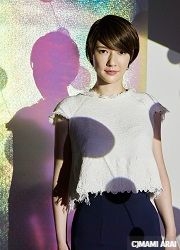Crossing Borders, Engaging in Exchanges and Harnessing the Power of Creation amid COVID-19
Interview and Contribution Series <8>
Sputniko!, Artist, Speculative Designer and Associate Professor, Tokyo University of the Arts
November 29, 2021
[Special Feature 073]
In this eighth issue of our special feature, "Crossing Borders, Engaging in Exchanges and Harnessing the Power of Creation amid COVID-19" (click here for a special feature overview), we welcome Sputniko!, an artist and speculative designer. She questions conventions about gender and bioethics through her artwork making full use of technology. What does she foresee for the future of communications, the Internet and art during the pandemic?
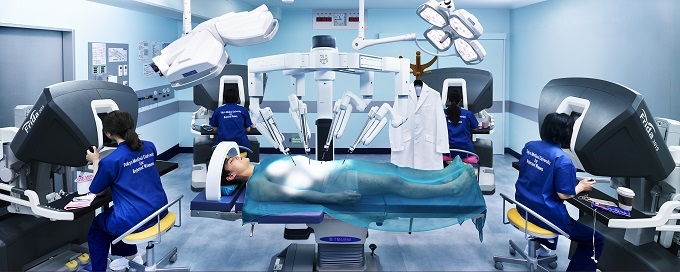 Tokyo Medical University for Rejected Women
Tokyo Medical University for Rejected WomenCreated by Sputniko! and Nishizawa Tomomi
Some medical schools in Japan got accused of deliberately lowering the entrance exam scores of female applicants. Two artists founded an imaginary medical school where male doctors are modified into perfect flawless elite doctors by female students whose exam scores had been lowered and rejected from Japanese medical schools (2019).
―― How have you been spending your time since the COVID-19 pandemic started?
I participated in the Future and the Arts: AI, Robotics, Cities, Life - How Humanity Will Live Tomorrow exhibition at the Mori Art Museum, which was canceled mid-exhibition in March 2020 and shifted to an online VR exhibition. Another exhibition in Israel was also canceled midway through; however, it subsequently resumed with new rules.
I used to go abroad at least once a month. In 2019, I went to so many places: the U.S., Singapore, the U.K., France, Switzerland, Germany and China.
I believe that going abroad helps you objectively see your way of thinking and lifestyle. If you stay in the same culture and society for a long time, you may become blind to certain things. When I go to other countries and compare them with Japan (or wherever I reside at that time), I can feel free. It allows me to meet people with diverse ways of thinking and get pieces of inspiring information directly.
The way I work differs for Japan and for overseas. During the pandemic I have few opportunities to express myself overseas, which is hard and very stressful for me. On the other hand, I can concentrate on tasks better than before now that I don't travel abroad and my meetings are mainly online.
With constraints on movement, I think more about how I should invest my time. I think some people were leading a hectic life, but now have the time to stop to think about what business to do or what the world should be like after the pandemic.
I have been conducting all of my classes at the Tokyo University of the Arts over the Internet. However, I can feel my students are frustrated because there are many occasions when they have to be there in person during practical classes, such as making works of art or having access to workshops. A good thing about online classes is that it is easier to invite designers in London and architects in New York to give lectures.
I was a TED Fellow speaker at the TED Talks*¹ in 2019. All of their conferences are conducted online now. While TED is a place full of many different and interesting people and discoveries, watching a TED Talk online is a different experience from in-person discussions with a lot of serendipity. It's a bit of a pity, but because of the pandemic, the opportunity of encountering people has been very limited. Working from home and holding meetings online have some advantages; however, they are not ideal. The year 2020 has been frustrating for everybody because we haven't been able to see other people or go out.
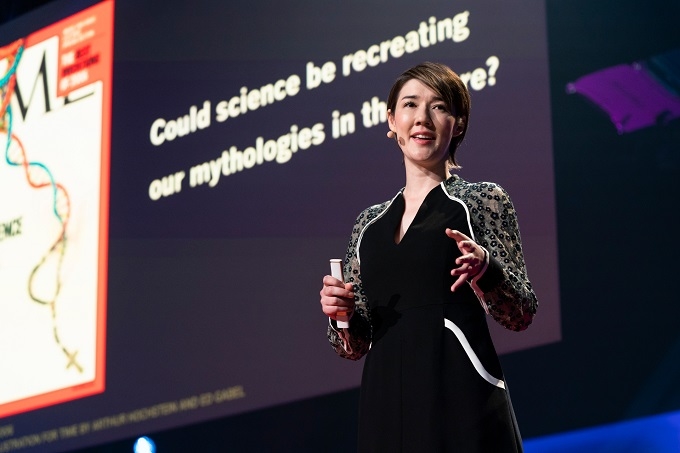 Sputniko! presenting at TED2019
Sputniko! presenting at TED2019――There is something you can only get face-to-face because you can actually see people.
At events like TED, you can casually speak to the people sitting next to you during lunch and make friends, which could lead to talk about projects and ideas. However, at online symposiums, it is difficult to casually make friends with other people.
I am afraid I have much less input because I cannot go abroad. So, I try to get as much information as possible, but the information you get from social media can be nonsense, and unless you are careful you only receive limited information from your filter bubble. That's why I think much harder about what sort of information I should obtain now.
――In Skype Song, your work in 2009, you asked a question: Are we really connected via Skype? Today, many people seem to be asking the same question. It has been some time since you released your work. What are your thoughts now on this question?
Skype Song (the official YouTube channel)
To be honest, I'm much more pessimistic than 10 years ago. It may not be appropriate to say this because I know I have to say something positive in interviews like this to provide a ray of hope (smiles wryly).
Around 2010, when I finished graduate school and created Menstruation Machine――Takashi's Take, social media represented a culture totally different from the current one, where many early adopters provided edgy ideas and forward-thinking comments. About 10 years ago, I felt like the Internet was a sort of medium where even progressive ideas would be disseminated if you shared rebellious content as an antithesis to conservative mass media.
Mass media were often conveyed with the majority perspective of, say, straight Japanese men in Japan and straight white men in the U.S., and tended to lack the perspectives of women, LGBTQ+ or racial and ethnic minorities. But at the time, I felt like the Internet was more like a place for rebellious or DIY cultures. If you wanted to start a project, you could turn to crowdfunding. Back then, I had the confidence and vision that if I recruited team members for an art project via the Internet and presented the work online, I could widely spread visionary, progressive ideas which were still seen as taboo and oppressed in the mainstream media. Ten or 15 years ago, the Internet was often called a "future utopia."
In fact, the Internet accelerated the #MeToo movement and exposed the violence against people of color through the Black Lives Matter movement, bringing about change in consciousness. Today, however, I am worried about the backlash to many of the changes achieved by these movements.
If every member of society participates in the Internet, there is a tendency that minority rights get challenged and criticized, while very extreme hateful opinions get a lot of attention and wide acceptance. Extreme anti-feminism, racism and hate can stand out and attract supporters easily. For example, the U.S. has been so divided that supporters of each presidential candidate have not been able to engage in heart-to-heart communication with each other.
Progressive opinions often face a danger of being severely attacked by the masses. It's similar to Galileo Galilei getting tried by the Catholic Church when he said the Earth revolved around the Sun.
In particular, the environment around the Internet in Japan is becoming a place where many so-called "critics" gang up on people engaged in activities or remarks that challenge them, including artists and activists. It looks like the beginning of backlash that could occur in Japan. The term jishuku keisatsu(citizens keeping vigilant eyes on fellow citizens whether they are following stay-at-home requests) has prevailed in Japan during the COVID-19 pandemic.
In this situation, a lot of people could shy away from doing something progressive even though you want to do it. Artists start to hesitate to publish their works on the Internet.
I'm afraid that Japanese people would rather voluntarily refrain from doing what they want to do than dividing their country. I have recently seen signs of this, which has been exacerbated since the start of the pandemic. COVID-19 has forced us to be more connected online than before. Without sufficient rules or laws to control online slander, some celebrities opted to take their own lives.
Today, many people are voluntarily restraining, censoring and monitoring their actions on the Internet. As an artist, I have sensed this restrained feeling and come to think hard about what comes next.
I create my works in the realm of speculative design; in other words, I design to raise questions and stimulate discussions about various issues about technology and the future. I used to invite people to discuss my work on the Internet. Today, however, the Internet is full of trashy, thoughtless and hateful opinions called kuso-ripu (shitty replies), which cannot even be defined as discussions. The quality of "debate" on the Internet has really deteriorated in the past 15 years. Even if you try to have a discussion, a lot of people are just throwing senseless gibberish to each other without listening to others.
What is progress? This is the question with which I am currently wrestling. We used to believe the Internet was the future, a progress for humanity, fulfilling our wishes and empowering minorities. However, the situation is swinging toward the negative. The COVID-19 pandemic has made me see the beginning of the end.
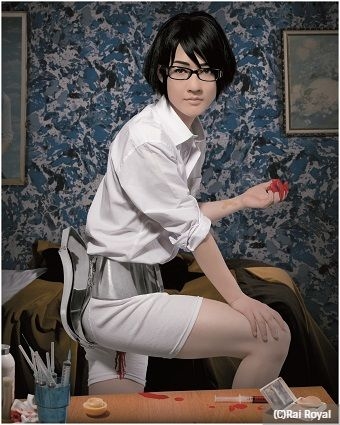 Menstruation Machine――Takashi's Take
Menstruation Machine――Takashi's TakeSputniko! developed a machine that enables biological men to experience menstruation (2010). Electrodes send dull pains to the abodomen, and 80 milliliters of "blood" run from a tank on the back (the average over five days of menstrual bleeding).
―― How do you keep in contact with people overseas now?
I continue to work with people overseas online. For example, I am currently preparing an exhibition in Asia with an overseas team. I am also communicating with a team in Europe about a new project. I also give lectures at overseas universities and talks at overseas conferences. In a way, the pandemic has made it easier for me to participate in international events remotely.
―― At the Tokyo University of the Arts, you led a student exhibition*² by giving them the task of discovering positive elements of the COVID-19 pandemic and presenting a design that provided a hopeful vision of the future. How was this collaboration?
At that time, it had been a couple of months since the pandemic began. I asked students to research and analyze the current situation.
Although Japanese students are more inclined to look for correct answers, I want my students to observe the current times critically. I asked them to observe the current times in an honest, spontaneous way, not from the perspective of right or wrong and consider the future scenarios themselves.
I think it is equally or more important to have the ability to observe the modern world and come up with their own answers, rather than talking about what a design history book says or saying a correct answer. Some Asian students who are used to the traditional education find it confusing, but I think they learn very fast.
Wherever you look, you cannot find the right answer to how to deal with COVID-19. So, you have to make yourself find answers. It was good that students did research, thought about solutions and proposed ideas themselves in a responsible way.
Many groups got to thinking about environmental issues. Another group mocked the jishuku keisatsu, the people who monitor other people's self-restraint. It was really interesting.
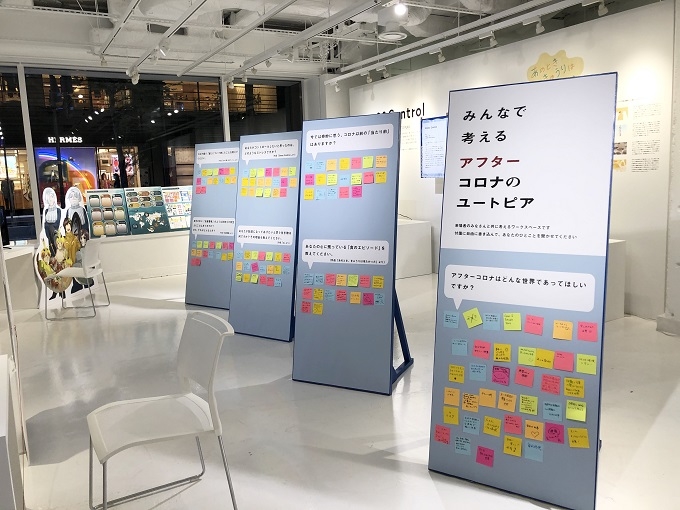 The Utopia after COVID-19 exhibition at the Tokyo University of the Arts
The Utopia after COVID-19 exhibition at the Tokyo University of the Arts―― Under the current situation, many university students cannot go to school or enjoy their school days. Do you have a message for them?
I feel very sorry for them, but being at a formative age while they are experiencing the pandemic will probably cause them to think about many things, and this will help them develop further.
It is said that a lot of great design philosophy and conceptual architecture are likely to appear during economic stagnation. It is because you are not as busy as before that you can spend plenty of time thinking and creating ideas for the future. I think we can regard them as students in those kinds of special times.
But, to be honest, it's getting hard for me. I really do hope the pandemic ends soon!
Stores and restaurants are closing down one after another. It is such a disaster. Some say online activities are great, and working from home is great. I want to say that it is terrible (laughs). OK, I don't mind having work or faculty meetings online, but I miss going out with friends at night.
The pandemic brought the whole world to a standstill and put a lot of people in financial jeopardy. Also, more people, especially women in Japan, are committing suicide. The current situation is so absurd it seems like a war. It is really exhausting.
―― In the vein of the theme of the Tokyo University of the Arts exhibition, is there any hope for the future?
The students profoundly researched and thought about the exhibition. They were very conscious of the idea that they were designing the future. It was very hopeful.
Obviously, design is not merely creating desirable products according to clients' requests. It entails the envisioning of futures and the presentation of the following steps. I feel hopeful that the students came around to realize that.
Students, the young generation, are our hope. I find that students have a different understanding of gender from other age groups. Compared to my generation, male students are already more aware of equality between the sexes and are highly conscious of gender and LGBTQ+ rights. Although I am pessimistic about society, the consciousness of the young generation is changing for sure, and I hope they are able to build a better future.
―― I think a cataclysm can inspire creativity. Do you think a situation like this will have any positive effects?
Absolutely yes. Cataclysms inspire creation. I have no doubt about it.
―― Why do you raise issues through art and design?
I was inspired very much by the artists and musicians who made people think about alternative futures through their music or fine art, such as John Lennon with "Imagine" and Laurie Anderson.
―― People have used technology to make the world more convenient and efficient. It is very interesting you use cutting-edge technologies for art or things that are not practical at a glance.
I have a perspective that doubts practical things. That's why I tend to create strange works (laughs), suggesting different uses for materials to create something different or expressing a different point of view. I always think about the next thing to come when I am working on something. This is how I create. I find a topic I want people to think about and raise issues.
―― The whole world is dealing with the COVID-19 pandemic at the same time. Because of this, there is the possibility of global solidarity. On the other hand, there is the likelihood of a movement toward anti-globalization due to the absence of popular movements across borders. What do you think the world is going to be like in the future?
I'm afraid the world will move toward anti-globalization. I hope not, though.
The pandemic is forcing people to stay at home. People haven't been able to travel abroad for a year or two, and the impact of this is going to reverberate. Even after the pandemic, people may have grown accustomed to staying at home.
In addition, I feel the Internet is divided into two: an American one and a Chinese one. Available services and apps totally differ from each other. Search results also completely differ between Google and Baidu.
I often heard of stories about physical walls such as the Berlin Wall and the demilitarized zone (DMZ) in the 20th century. I think we will feel the walls of the Internet in our daily lives for dozens of years from now.
I also worry if Japanese people really think about diversity, feminism or LGBTQ+ issues. I doubt they really understand these issues when proposing ideas. In the U.S., diversity is important in reality because it is a country of immigrants. But Japanese people seem to lack an understanding of the essence of multiethnic issues.
The whole world is moving toward anti-globalization. Japan also has the potential to go down the same road.
―― As an artist, you will act against this. Today is a tough time but it also presents you with challenges.
That's right. Many artists are experimenting with many different styles to create.
- *¹ TED Talks: Speaking events featuring remarkable speakers from many countries working in many different fields. The video of Sputniko!'s 2019 TED Talk is available on the TED Talks website. https://www.ted.com/talks/hiromi_ozaki_how_i_bring_myth_and_magic_to_life
- *² Utopia after COVID-19, an exhibition at the Tokyo University of the Arts http://design.geidai.ac.jp/news/2020-09-04-3536/
Online interview in October 2020
Interview/text: Terae Hitomi (Japan Foundation Communication Center)
Photos courtesy of Sputniko!
Related Articles
Back Issues
- 2025.6.24 Exclusive Interview:…
- 2025.5. 1 Ukrainian-Japanese I…
- 2024.11. 1 Placed together, we …
- 2024.5.24 The 50th Japan Found…
- 2024.5.24 The 50th Japan Found…
- 2024.5. 2 People-to-People Exc…
- 2024.2.19 Movie Theaters aroun…
- 2024.2.19 Movie Theaters aroun…
- 2023.4.24 The 49th Japan Found…
- 2022.10.24 Inner Diversity <2> …


